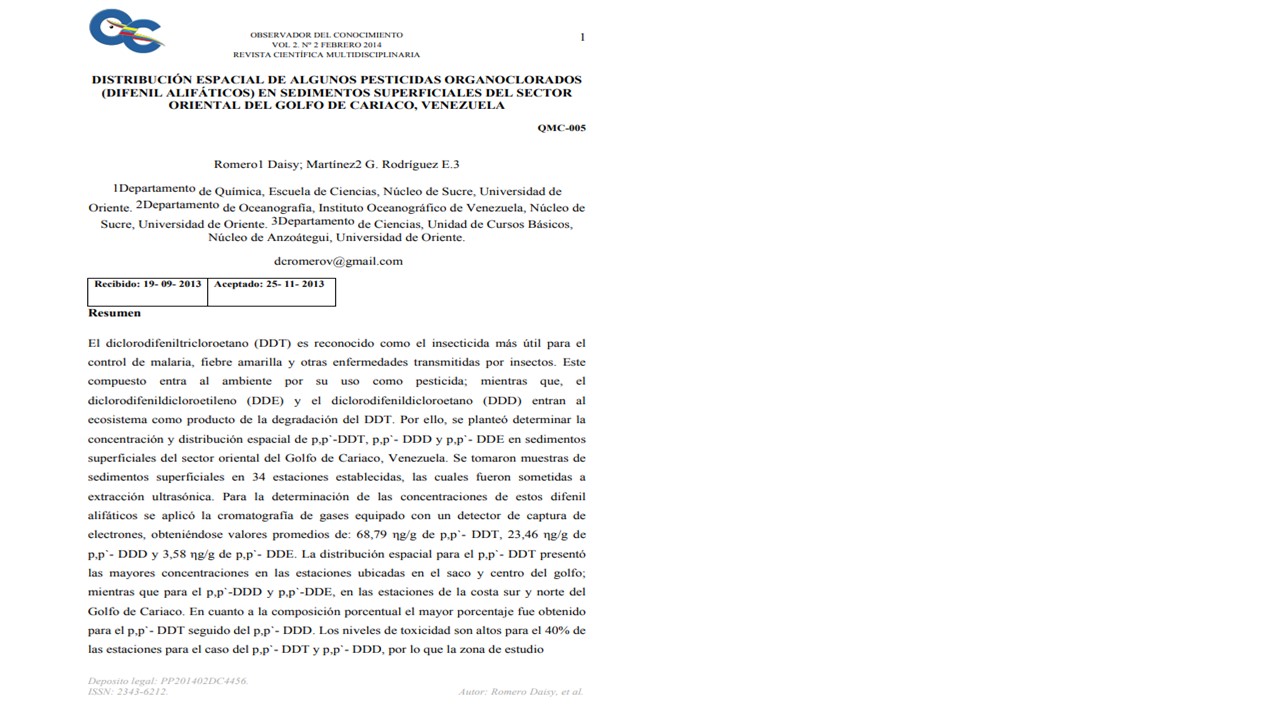Space Distribution of Some Organoclorated Pesticides (Difenil) Aliphatic) in Surface Sediments of The Oriental Sector of The Gulf of Cariacus, Venezuela
Keywords:
Pesticides, sediments, DDT, gulfAbstract
Dichlorodiphenyltrichloroethane (DDT) is recognized as the most useful insecticide for the control of malaria, yellow fever and other diseases transmitted by insects. This compound enters the environment due to its use as a pesticide; whereas, dichlorodiphenyldichloroethylene (DDE) and dichlorodiphenyldichloroethane (DDD) enter the ecosystem as a product of the degradation of DDT. Therefore, it was proposed to determine the concentration and spatial distribution of p, p`-DDT, p, p`- DDD and p, p`- DDE in superficial sediments of the eastern sector of the Gulf of Cariaco, Venezuela.
Downloads
References
ATSDR (Agencia para Sustancias Tóxicas y el Registro de Enfermedades). 2002. Reseña Toxicológica del DDT/ DDE/DDD. Atlanta, GA: Departamento de Salud y Servicios Humanos de los EE.UU., Servicio de Salud Pública.
Características hidrográficas del Golfo de Cariaco, Venezuela. Boletín del Instituto Oceanográfico de Venezuela, Universidad de Oriente, 17 (1-2), 69-88.
Determination of PAHs in marine sediments: analytical methods and environmental concerns. Global NEST Journal, 11 (4), 391-405.
El Nemr, A. Moneer, A. A., Khaled, A. y El-Sikailyn, A. (2012). Levels, distribution, and risk assessment of organochlorinesin surficial sediments of the Red Sea coast, Egypt. Environmental Monitoring and Assessment, 185 (6), 4835-53.
Falahudin, D., y Munawir, K. (2012). Distribution and sources of persistent organochlorine pesticides in seawater and sediments in transitional season from Banten bay. Journal of Coastal Development, 15 (2), 142- 153.
Grabe, S., y Barron, J. (2004). Sediment contamination, by habitat, in the Tampa Bay estuarine system (1993-1999): PAHs, pesticides and PCBs. Environmental Monitoring and Assessment, 91, 105-144. Lara-Martín, P., Petrovic, A., Barceló, D. y González-Mazo, E. (2005). Distribución de contaminantes orgánicos en sedimentos costeros de la Bahía de Cádiz. Ciencias Marinas, 31(1B), 203- 212.
Long, E., Macdonald, D., Smith, L. y Calder, F. (1995). Incidence of adverse biological effects within ranges of chemical concentrations in marine and estuarine sediments. Environmental Management, 19, 81-97.
Martínez, G. (2002). Metales pesados en sedimentos superficiales del Golfo de Cariaco, Venezuela. Boletín del Instituto Oceanográfico de Venezuela, Universidad de Oriente, 41 (1-2), 83-96. Menone, M., Miglioranza, K., Botto, F., Iribarne, O., Qizpun J. y Moreno, V. (2006). Field accumulative behavior of organochlorine pesticides. The role of crabs and sediment characteristics in coastal environments. Marine Pollution Bulletin, 52, 1717-1724.
Ministerio del Poder Popular para la Salud. (2008). Boletín Epidemiológico, Semana 53, Venezuela. Nikolaou, A., Kostopoulou, M., Lofranos M. y Meric, S. (2009).
Okuda, T., Benítez, J., Bonilla, J. y Cedeño G. (1978).
Orozco-Borbón, M. V., de la Rosa-Vélez, J., Ramírez-Álvarez, N., Macías- Zamora, V., Gutiérrez-Galindo, E. A. y Muñoz-Barbosa, A. (2008). DDT in sediments from the northwest coast of Baja California (Mexico) and its biotransformation by Vibrio sp. Ciencias Marinas, 34 (4), 419-432.
Partida-Gutiérrez, D., Villaescusa, J., Macías-Zamora J y Castillón, F. (2003). Contaminantes orgánicos persistentes en núcleos de sedimentos de la región Sur de la Cuenca de Las Californias. Ciencias Marinas, 29 (4), 521-534.
Quintero, A., Terejova, G., Vicent, G., Padrón, A. y Bonilla, J. (2002).Los pescadores del Golfo de Cariaco, Venezuela. Interciencia, 27 (6), 286-292.
Rodríguez, E: J., Romero, D. C., Martínez, G. J., Fermín, I. M. y Senior, W. (2012). Influencia del rio Manzanares en la biodisponibilidad de metales pesados (Co, Cr, Pb, Zn) en la zona costera frente a la ciudad de Cumaná, estado Sucre, Venezuela. Avances en Química, 7 (1), 57-63.
Storelli, M., Perrone, V. y Marcotrigiano, G. (2007). Organochlorine contamination (PCBs and DDTs) in deep-sea fish from the Mediterranean Sea. Marine Pollution Bulletin, 54, 1662-1689.
Veljanoska-Sarafiloska, E., Jordanoski, M., Stafilov, T. y Stefova, M. 2011. Study of organochlorine pesticide residues in water, sediment and fish tissue in lake Ohrid (Macedonia/Albania). Macedonian Journal of Chemistry and Chemical Engineering, 30 (2), 163–179.
Ware, G. y Whitacre, D. (2004). The Pesticide Book, 6th ed. Ohio: Meister Media Worldwide Willoughby.
Wasswa, J., Kiremire, B. T., Kizza,P. N.,Mbabazi,J.ySsebugere,P. (2011). Organochlorine pesticide residues in sediments from the Uganda side of LakeVictoria.Chemosphere,82,130- 136.
WHO (World Health Organization). 1979. DDTs and its derivations. New York: WHO.

Downloads
Published
How to Cite
Issue
Section
License

This work is licensed under a Creative Commons Attribution-NoDerivatives 4.0 International License.







